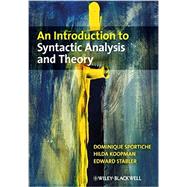
What is included with this book?
Dominique Sportiche is Professor of Linguistics at the University of California, Los Angeles, École Normale Supérieure in Paris, and Institut Jean Nicod at the Paris Institut d’Étude de la Cognition. Specializing in theoretical syntax, he has published widely on the syntax and the properties of the syntax/semantics interface of English and French.
Hilda Koopman is Professor of Linguistics at the University of California, Los Angeles. Her theoretical interests include theoretical syntax and morphology and comparative syntax. She has published on a wide range of topics covering many diverse languages. Her work is often based on original fieldwork.
Edward Stabler is Professor of Linguistics at the University of California, Los Angeles. His specialty is in computational models of human syntactic analysis and learning, and he has published on a wide range of topics in mathematical and computational linguistics.
Acknowledgments xv
1 Introduction 1
1.1 Where to Start 1
1.2 What this Book is and is Not, and How to Use It 5
1.3 Further Reading 6
2 Morphology: Starting with Words 9
2.1 Words Come in Categories 10
2.2 Words are Made of Smaller Units: Morphemes 17
2.3 Morphemes Combine in Regular Ways 18
2.4 Apparent Exceptions to the RHHR 32
2.5 Morphological Atoms 35
2.6 Compositionality and Recursion 36
2.7 Conclusion 37
3 Syntactic Analysis Introduced 43
3.1 Word Order 44
3.2 Constituency 47
3.3 Syntactic Productivity 48
3.4 Substitution 50
3.5 Ellipsis 58
3.6 Coordination 62
3.7 Movement and Other Distortions 68
3.8 Some More Complex Distortion Experiments, Briefly 74
3.9 Some More Practice 75
3.10 Some Other Evidence of Constituency 76
3.11 Conclusion 78
4 Clauses 87
4.1 Full Clauses: CPs 87
4.2 Tense Phrase 94
4.3 Conclusion 98
5 Other Phrases: A First Glance 105
5.1 Verb Phrases 105
5.2 Determiner Phrases 113
5.3 Noun Phrases 116
5.4 Adjective Phrases 119
5.5 Prepositional Phrases 119
5.6 Ways to Talk About Tree Geometry 119
5.7 Conclusion 120
6 X-bar Theory and the Format of Lexical Entries 127
6.1 Review: The Model of Morphology 127
6.2 Building a Model of Syntax 129
6.3 Headedness 130
6.4 Internal Organization of Constituents 131
6.5 Some Consequences 134
6.6 Cross-categorial Symmetries 137
6.7 Subjects Across Categories: Small Clauses 138
6.8 Lexical Entries 140
6.9 The Projection Principle and Locality 146
6.10 Cross-linguistic Variation 149
6.11 Conclusion 151
7 Binding and the Hierarchical Nature of Phrase Structure 157
7.1 Anaphors 159
7.2 Pronouns 169
7.3 Non-pronominal Expressions 171
7.4 Binding Theory Summarized 172
7.5 Small Clauses and Binding Theory 173
7.6 Some Issues 174
7.7 Cross-linguistic Variation 178
7.8 Learning About Binding Relations 181
7.9 Conclusion 183
8 Apparent Violations of Locality of Selection 187
8.1 Setting the Stage 187
8.2 Topicalization: A First Case of Movement 189
8.3 Head Movement 191
8.4 Detecting Selection 206
8.5 Phrasal Movements 210
8.6 How Selection Drives Structure Building 221
8.7 Addressing some Previous Puzzles 225
8.8 Synthesis 226
8.9 Terminology and Notation 230
8.10 Conclusion 230
9 Infinitival Complements: Raising and Control 239
9.1 Subject Control 240
9.2 Using the Theory: Control and Binding 244
9.3 Interim Summary: Inventory of To-infinitival 248
9.4 Raising to Object/ECM and Object Control 249
9.5 Conclusion 252
10 Wh-questions: Wh-movement and Locality 259
10.1 Introduction 259
10.2 The Landing Site or Target Position of Wh-Movement 261
10.3 What Wh-movement Moves 263
10.4 Locality I: The Problem 266
10.5 Locality II: Theory of Constraints 281
10.6 Special Cases 293
10.7 Conclusion 298
11 Probing Structures 305
11.1 Introduction 305
11.2 Probing Derived Structures 305
11.3 Probing Underlying Structures 312
11.4 Probing with Binding 315
11.5 Conclusion 324
12 Inward Bound: Syntax and Morphology Atoms 331
12.1 The Size of Atoms 332
12.2 Head Movement and the Head Movement Constraint 332
12.3 Causative Affixes: Syntax or Morphology? 335
12.4 VP Shells 339
12.5 Ternary Branching 348
12.6 Using VP Shells: VP Shells and Adjuncts 357
12.7 Terminological Changes 362
12.8 Raising to Object 363
12.9 The Model of Morphosyntax 364
12.10 Conclusion 367
13 Advanced Binding and Some Binding Typology 377
13.1 Basics: Reminders 377
13.2 Reminder About Principle A 380
13.3 Subjects of Tensed Clauses 380
13.4 VP shells and the Binding Theory 382
13.5 Binding Variation and Typology 387
13.6 Conclusion 397
14 Wh-constructions 403
14.1 Diagnostic Properties of Wh-movement 403
14.2 Relative Clauses 405
14.3 Another Case of Null Operator Movement: Tough-Construction 413
14.4 Topicalization and Left Dislocation 415
14.5 Other Wh-movement Constructions 417
14.6 Conclusion 419
15 Syntactic Processes 421
15.1 The Language Model: Defining Structure 422
15.2 Selection, Movement, Locality 423
15.3 Computational Properties of the Model 427
15.4 Conclusion 433
References 435
Index
The New copy of this book will include any supplemental materials advertised. Please check the title of the book to determine if it should include any access cards, study guides, lab manuals, CDs, etc.
The Used, Rental and eBook copies of this book are not guaranteed to include any supplemental materials. Typically, only the book itself is included. This is true even if the title states it includes any access cards, study guides, lab manuals, CDs, etc.